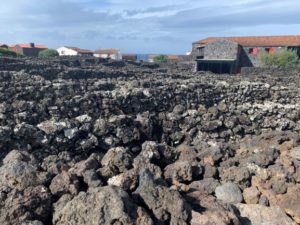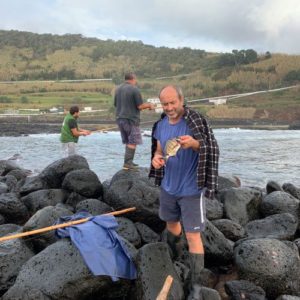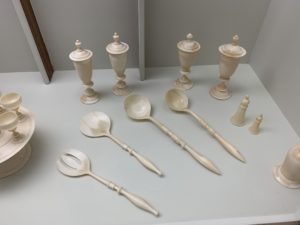The Island of Pico is the youngest in the Azores archipelago and is called the black island due to the abundance of black volcanic rock. Although it is the second largest of the islands in the Azores only about 14,000 people inhabit the island, or about 6% of the population of the Azores. The village of Lajes was the first settlement on the island and is the location of the only sailboat port. The docks can be very rough at high tides, especially with westerly winds, so cruisers are advised to be prepared. A lager commercial port is present in the town of Madalena.

The rich volcanic soil has been used to product wines since the 1700s and Pico is a UNESCO world heritage site because of the beautiful landscape and culture associated with the island’s vineyards. The small walled plots helped keep the grapes warm and protected the vines from the moist salty air.
Pico is also known for hiking with a dozens official well-maintained hiking trails, the most famous of which summits the top of mount Pico, the highest place in Portugal. All climbers of Pico must check in at Casa da Montanha and be fitted with a GPS tracker to climb the volcano. The 12.3 mile out and back Nove Canadas da Ribeirinha is also highly recommended by locals who enjoy hiking.

The people of the Azores love to fishing and swimming in the ocean. People fishing or collecting bait for fishing is something you see daily while exploring Pico. A number of towns and villages created pools cordoned off from the ocean where locals swim.
Bus service is available on Pico and an inexpensive way to see the quaint towns around the Island. Round trip fare to about anywhere runs about 4 euros. Travel times must be carefully planned as there are only a couple buses a day. See Christiano Limitada for more information on Pico bus service.
The north coast of the Island is truly striking and my favorite part of the island. Jet black cliffs rise from the sea and the elongated coastline of São Jorge can be seen in the distance. The Landscape of the Pico Island Vineyard Culture Interpretation Centre and the more kid friendly Volcanoes’ house are located in the picturesque town of Lajido. Both are worth a visit.
Whaling is a sad but interesting part of the culture of the Azores and the Island of Pico has two whaling museums.

In Lajes do Pico the Museu dos Baleeiros is really well done and has a stunning collection of scrimshaw. On the North coast the Museu da Indústria Baleeria has offer a tour of an old whaling factory. While the machinery is quite interesting, the picture of the whaling process were a bit gruesome. The people of the Azores are not proud of their past history of whaling and these centers seem to serve as reminders of the mistakes of the past.
In a place as beautiful as Pico it is difficult not the be captivated by nature. A number of people have told me here in the Azores, “Nature is most important” or “Nature is all we have.” This is evidenced by the Cory’s Shearwater campaign ongoing during the month of November, Young Shearwaters tire as they learn to fly and are frequently seen resting on roadways. It is common to see locals moving them to a location where they are safe from cars. Early one morning I encountered a volunteer who releases 200 Shearwaters a day. The inhabitants of the island bring them to local fire stations in boxes and volunteers collect and release them.